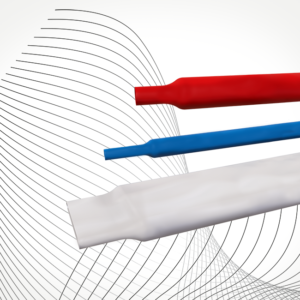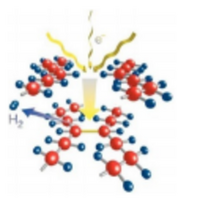Radiation-crosslinked polyolefin: high-quality heat-shrink tubing
Polyolefins are an important group of polymers produced by the polymerization of unsaturated hydrocarbons. The most commonly used polyolefins include polyethylene (PE) and ethylene vinyl acetate (EVA). Polyethylene itself comes in different types, including linear low-density polyethylene (LLDPE), low-density polyethylene (LDPE), medium-density polyethylene (MDPE) and high-density polyethylene (HDPE). While non-crosslinked polyethylene provides good dielectric, mechanical, and chemical properties and simple processing options, some limitations can be overcome through radiation crosslinking.
What is radiation crosslinking?
The radiation crosslinking of polyethylene produces radiation-crosslinked polyolefin. This process involves exposing the material to ionizing radiation, such as electron beams or gamma rays. The usual radiation dose is between 50 and 150 kGy, depending on the specific requirements of the application. This radiation causes neighboring polymer chains in the material to form strong bonds at the points where hydrogen atoms are split. This three-dimensional network of linked chains significantly improves the physical properties of the material.
Advantages of radiation-crosslinked polyolefin
Radiation-crosslinked polyolefin offers several outstanding advantages that make it particularly attractive for demanding applications. At temperatures above the melting point, cross-linked polyethylene becomes soft and elastic, similar to rubber. By contrast, non-cross-linked polyethylene becomes a ductile, liquid mass. The material has excellent temperature resistance. It withstands temperatures of up to 125 °C continuously and up to 150 °C for short periods. Its chemical resistance is also remarkable, as it is resistant to oils, solvents, and acids. In addition, it offers high abrasion resistance with abrasion values according to ISO 4649 below 0.5 mm, which minimizes mechanical stress and extends service life. It remains flexible and dimensionally stable even at temperatures as low as -40 °C.
Another important property is the “shape memory”, which enables the material to return to its original shape after heating. This is particularly useful for repairing and recovering insulation. A cross-linked heat-shrinkable tubing product with an adhesive layer can be applied to damaged insulation and conform closely to the repair area when heated, providing an effective, durable, and cost-efficient solution.
Applications of radiation-crosslinked polyolefin
Radiation-crosslinked polyolefin is widely used in various industrial sectors. In the automotive industry, it is used to insulate cables and wires exposed to high temperatures and mechanical stress. In the aerospace industry, it protects cables and wires from extreme temperatures and chemical influences. These products are also used in electrical engineering. Here it ensures reliable insulation in devices that have to fulfil high requirements in terms of temperature and chemical resistance. In the energy supply sector, it insulates high-voltage cables and critical components where maximum reliability is required.
Chemical cross-linking
Chemical crosslinking is an alternative method to radiation crosslinking. It is based on the reaction of polymers with chemical crosslinking agents to create a three-dimensional network of linked polymer chains. In contrast to radiation crosslinking, which is carried out using ionizing radiation, chemical crosslinking uses a crosslinking reagent such as peroxides, silanes, or other chemical compounds. Under certain conditions, such as increased temperature or the use of a catalyst, these substances cause a chemical reaction that permanently links the polymer chains together. Chemical cross-linking offers advantages such as better control over the degree of cross-linking and the ability to process large quantities of material in a single step. It can also be carried out under environmental conditions that do not require special radiation equipment. However, process conditions and chemical handling must be carefully monitored to ensure uniform crosslinking and the desired material properties.
Although chemical crosslinking offers some advantages, electronic radiation crosslinking is superior in principle. By precisely controlling the radiation process, a more uniform and controlled crosslinking is achieved. This results in better physical and chemical properties of the material. Therefore, electronic radiation crosslinking is the preferred method for applications that need to meet the highest performance requirements. Furthermore, this method is generally recognized as being more environmentally friendly, as there is no need for additional chemicals.
GREMCO’s expertise
GREMCO is a leader in the field of radiation cross-linked polyolefins, ensuring a wide range of high-quality cable protection solutions, with heat-shrink tubing as core expertise. The advanced technology of radiation cross-linked polyolefin ensures that GREMCO’s products meet the highest standards in terms of durability, performance, and reliability. This makes them the preferred choice for demanding applications in various industries.

Conclusion
Radiation-crosslinked polyolefin provides significant benefits such as excellent temperature and chemical resistance, high abrasion resistance, and a useful shape memory property. GREMCO’s advanced solutions provide companies with high-performance, long-lasting products that meet the highest industrial requirements.
We would be pleased to advise you on our product range and the possible applications of the Fitcoflex woven hose polyethylene. Please contact us!




